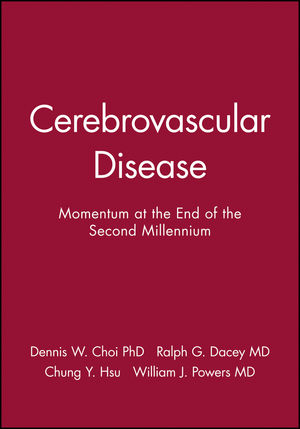Cerebrovascular Disease: Momentum at the End of the Second MillenniumISBN: 978-0-87993-484-2
Hardcover
455 pages
February 2002, Wiley-Blackwell
 |
||||||
Chapter 1. Overview.
Ralph G. Dacey Jr., MD and William J. Powers, MD.
Chapter 2. Cerebral Hemodynamics and Stroke Risk.
Robert L. Grubb Jr., MD, Colin P. Derdeyn, MD, Susanne Fritsch, RN, William J. Powers, MD.
Chapter 3. Extracranial-Intracranial Bypass: Surgical Considerations.
Marc R. Mayberg, MD.
Chapter 4. Extracranial-Intracranial Surgery for Patients with Proven Hemodynamic Compromise: Is There Sufficient Evidence for a Second-Phase EC/IC Trial?.
Henry J.M. Barnett, MD.
SECTION II. Mediators and Modulators of Ischemic Injury: Hot Topics.
Chapter 5. Poly(ADP-ribose) Polymerase in Ischemia-Reperfusion Injury.
Valina L. Dawson, PhD and Ted M. Dawson, MD, PhD.
Chapter 6. Superoxide Dismutase in Cerebral Ischemia.
Pak H. Chan, PhD.
Chapter 7. Estrogen as Neuroprotectant in Stroke.
Patricia D. Hurn, PhD, Nabil J. Alkaayed, MD, PhD, Barbara J. Crain, MD, PhD, Valina L. Dawson, PhD, Ted M. Dawson, MD, PhD, Allen S. Mandir, MD, PhD, Renata Rusa, MD, Kenji Sampei, MD, Masahiko Sawada, MD, Thomas J.K. Toung, MD, Richard J. Traystman, PhD.
Chapter 8. HMG-coAReductase Inhibitors Reduce Cerebral Infarct Size by Upregulating Endothelial Nitric Oxide Synthase.
Matthias Endres, MD, Ulrich Laufs, MD, James K. Liao, MD and Michael A. Moskowitz, MD.
SECTION III. White Matter Ischemia - Unique Mechanisms of Injury?.
Chapter 9. Ischemic Injury to the Cerebral White Matter: Neuropathology of Human and Experimental Lesions.
Leonardo Pantoni, MD, and Julio H. Garcia, MD (deceased).
Chapter 10. Approaches to the Study of the Cellular and Molecular Pathogenesis of Perinatal White Matter Injury.
Stephen A. Back, MD, PhD.
Chapter 11. White Matter Ischemia: Unique Mechanisms of Injury.
Peter K. Stys, MD.
Chapter 12. CADASIL: What can we Learn about White Matter Stroke?.
Marie-Germaine Bousser, MD, Hugues Chabriat, MD, Anne Joutel, MD and Elizabeth Tournier-Lasserve, MD.
SECTION IV. Inflammation.
Chapter 13. Introduction.
John M. Hallenbeck, MD.
Chapter 14. Infection and Stroke Risk.
Mark Fisher, MD.
Chapter 15. The Extracellular Matrix and Focal Cerebral Ischemia.
Gregory J. del Zoppo, MD.
Chapter 16. Some Principles of the Inflammatory Reaction to Brain Ischemia: Sense and Purpose.
Julie A. Ellison, PhD, Franc C. Barone, PhD and Giora Feuerstein, MD.
Chapter 17. Reperfusion Damage in the Brain.
Ping-An Li, MD, PhD, Tibor Kristian, PhD, Yi-Bing Ouyang, PhD and Bo K. Siesjö, MD, PhD.
Chapter 18. Debate: Heparin Should Be Used to Treat Patients Presenting with Acute Stroke or Stroke-in–Evolution: Affirmative Position.
Louis R. Caplan, MD.
Chapter 19. Debate: Antiocoagulation in Acute Ischemic Stroke: Not Indicated.
Roger P. Simon, MD and William J. Powers, MD.
SECTION V. Beyond Diffusion: Imaging Measurements of Cerebral Blood Flow and Metabolism.
Chapter 20. Overview.
Justin A. Zivin, MD, PhD and Marc Fisher, MD.
Chapter 21. Measuring Oxygen Saturation Using Magnetic Resonance Imaging.
E. Mark Haacke, PhD, Weili Lin, MD, Benjamin Lee, MD, Daniel Kido, MD, Chung Y. Hsu, MD and William J. Powers, MD.
Chapter 22. Quantitative Measurement of Regional Blood Flow by Magnetic Resonance with Arterial Spin Tagging.
Alan C. McLaughlin, PhD, Frank Q Ye, PhD, Venkata S. Mattay, MD, Joseph A. Frank, MD, Daniel R. Weinberger, MD.
SECTION VI. Delayed Neuronal Death.
Chapter 23. The GluR2 Hypothesis of Ischemia-Induced Damage: Implications for Neuroprotection and Rescue.
Domenico E. Pellegrini-Giampietro, MD, PhD, Keiji Oguro, MD, PhD, Thoralf Opitz, PhD, Agata Calderone, MD, Michael V.L. Bennett, PhD and R. Suzanne Zukin, PhD.
Chapter 24. Fluorescent Indicator Measurements of Ca2+ Homeostasis in Postischemic CA1 Hippocampal Neurons.
John A. Connor, PhD, Anders C. Greenwood, PhD, Seddigheh Razani-Boroujerdi, PhD, Jeffrey J. Petrozzino, PhD and Rick C.S. Lin, PhD.
Chapter 25. Delayed Neuronal Death: A Perspective and Synthesis.
Myron D. Ginsberg, MD.
SECTION VII. Cortical Reorganization and Post-Acute Stroke Treatment.
Chapter 26. Introduction.
Alexander W. Dromerick, MD and Larry B. Goldstein, MD.
Chapter 27. Functional Remodeling of Motor Cortex after Stroke.
Randolph J. Nudo, PhD, Jeffrey A. Kleim, PhD and Kathleen M. Friel, MD.
Chapter 28. Growth Factors and Stroke Recovery.
Jing Mei Ren, MD, John Markman, MD, and Seth P. Finklestein, MD.
Chapter 29. Activity-Associated Growth Factor Expression and Related Neural Events in ecovery of Function after Brain Injury.
Timothy J. Schallert, PhD, J. Leigh Humm, MA, Sondra Bland, BA, Theresa Jones, PhD, Bryan Kolb, PhD, Jaroslaw Aronowski, PhD and James Grotta, MA.
SECTION VIII. Clinical Treatment Trials.
Chapter 30. Recent Clinical Trials of Neuroprotective Agents and Thrombolytic Therapy for Acute Stroke.
Gregory W. Albers, MD.
Chapter 31. Debate: MRI is a Good Endpoint for Determining the Efficacy of Stroke Treatment Trials: Affirmative position.
Steven J. Warach, MD, PhD.
Chapter 32. Debate: MRI is a Good Endpoint for Determining the Efficacy of Stroke Treatment Trials: Arguments against.
Joseph P. Broderick, MD



